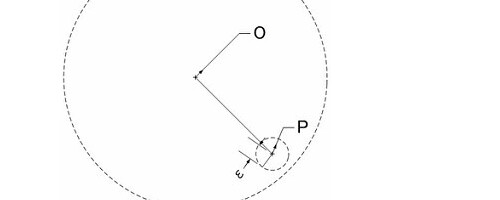
今回は大学数学の位相空間についてです.
本題は地味に理解するのが難しいんですが, 以降に述べる開集合, 閉集合, そして近傍の関わりを理解する上では大切になってきます.
スポンサーリンク
位相などの基礎知識
そもそも位相とは何か…というお話から.
でもその前に「空間」という言葉について.
空間
[定義:空間]
数的概念を扱う対象の集まり(対象が数であれば「集合」)を空間と呼ぶ.
表現を変えれば, 何かを行う上でのはじまりの集合を意味します.
何か計算をしたいとき, それは「そんな集合の上でやっているか」, それを具体的に表現したものです.
例えば を因数分解するとき, 実数の上で因数分解するのか複素数の上で行うのか…で, 答えは違ってきますね.
位相
[定義:位相]
空間 の上に定める構造の一つであり, 例えば
の部分集合が開集合であるか閉集合であるかを決めるフィルターである.
構造というのは空間に付与するものであり, 二項演算は勿論距離なども含まれます.
距離自体は, ただそれだけでは 上の写像に過ぎませんが, 距離
と正実数
について
なる集合 を定め, 集合
が以下を満たすとき,
は開集合となり, このような
を集めた系
について,
は位相空間になります.
まぁこの辺は今回はちょっと話がズレるので割愛します.
開集合の公理
まずは「位相空間の公理」として一般的な開集合の公理からです.
[定義1':開集合の公理]
集合 の任意の部分集合について, それが開集合であるかそうでないか…を定めるフィルター
が以下を満たすとき,
を位相と言い, また
を位相空間と言う.
(O'-1) 空集合 および
自身は開集合である, つまり
(O'-2) の開集合の族
に対して, その和集合もまた開集合である
(O'-3) が
の開集合ならば,
も
の開集合である
集合 には(
といったトリビアルなものでない限り)色んな部分集合があるわけですが, そのうち
を満たす集合
は開集合,
を満たす集合
は閉集合…とするわけです.
また (O'-2)は可算個の, (O'-3) は有限個の集合演算について閉じているという意味であることを確認します.
従ってこれを数学らしく書くと下のようになります.
[定義1:開集合の公理(別表記)]
集合 の部分集合の族
が以下を満たすとき,
を位相空間,
を位相と呼び,
の要素を(
の)開集合と呼ぶ.
(O-1)
(O-2) の任意の要素列
に対して,
(O-3)
因みに「族(=family)」は「集合を集めた集合」のことです.
「数の集まり」が集合なので「集合の集合」と言う代わりに族という言葉を使います(本当は系や類が正しいんですがここでは端折ります).
以降, 書き方はこちらで統一します.
ではまず閉集合, 近傍の定義から.
閉集合の公理
開集合の公理があるなら閉集合を使っても良いんじゃないの?…というのは正しいわけです.
[定義2:閉集合の公理]
集合 の部分集合による族
が以下を満たすとき, 集合
を位相空間,
を位相と呼び,
の要素を閉集合と呼ぶ.
(F-1)
(F-2)
(F-3) の任意の要素列
に対して,
開集合の公理と似ていますね?
近傍の公理
次は近傍の公理です.
本当は「開核」を使用した公理もあるらしいんですが今回は無しです.
ここで言うところの近傍, 例えば が
の近傍とは, 「
の点
を内点として含む集合」と意味します.
[定義3:近傍の公理]
集合 の任意の点
, 部分集合
が以下を満たすとき,
を位相空間, 条件を満たす
をすべて集めた集合(系)
を位相と呼ぶ.
(N-1)
(N-2)
(N-3) であり,
の部分集合
が
を含むならば,
(N-4)
(N-5) ならば,
となる
が存在して,
に対して
は
の近傍.
以上を踏まえて, これらが互いに同値であることを示すのが今回の目的です.
スポンサーリンク
開集合の公理⇒近傍の公理
まずは開集合の公理から近傍の公理が導かれることを示します.
集合 は開集合の公理を満たしているとし, 開集合の族を
, また近傍を次のように定めます.
[定義:近傍]
は
上の点であり,
を,
を含む
の部分集合とします.
このとき, ある開集合 が存在して
を満たすとき, は
の近傍と言う.
定義の通り, 近傍は開集合である必要はありません.
近傍が開集合であるとき, 特別に開近傍と呼び, こちらを近傍の定義にする流儀もあります.
どちらが正しいかは参考書次第です, ここでは上記を近傍とします.
では開集合の公理とこの近傍の定義を用いて, 近傍の公理が導かれることを示しましょう.
「開集合の公理⇒近傍の公理」の証明
N-1:
(O-1) より , 従って
は開集合です.
なので
は明らかです, よって上記の近傍の定義から
は
の近傍なので
が言えます.
N-2:
これは仮定の と近傍の定義より
なので自明に成り立ちます.
N-3: であり,
の部分集合
が
を含むならば,
これも近傍の定義から
が言えるので成り立ちます.
N-4:
を
の近傍とすると, 近傍の定義から, ある開集合
が存在して
を満たします.
このとき, 開集合の公理 O-3 より
は開集合であり,
となりますから, 近傍の定義より もやはり
の近傍であることが分かります.
N-5: ならば,
となる
が存在して,
に対して
は
の近傍
が
の近傍であるとすると, 近傍の定義からある開集合
が存在して
となります, 当然
でもありますから, 自身も
の近傍です.
加えて, の任意の点
に対して
が成り立つので, は
の近傍でもあります.
従ってこの を
に差し替えることで望む結論が得られます.
以上により, 開集合の公理から近傍の公理が導かれました.
そしてこのとき, 次の命題が成り立ちます.
以下の命題は近傍を特徴づける性質であり, 「近傍の公理⇒開集合の公理」を導く際にその定義としての役割を持ちます.
同じようなことが他の場合でも存在します.
定理1
集合 は開集合の公理を満たすとする.
が
の部分集合であるとき, 次の2つは同値である.
(1) は開集合.
(2) の任意の点
に対して,
は
の近傍.
[定理1の証明]
(1)⇒(2)
仮定から は開集合であり,
なる
を任意にとると
なので, 近傍の定義より は
の近傍になります.
(2)⇒(1)
の任意の点
に対して
が
の近傍であるとき, 近傍の定義より 各々の
に対してある開集合
が存在して
とできます.
このとき, 開集合の公理 (O-2) より は開集合になります.
近傍の公理⇒開集合の公理
次は先程の逆を示します.
同じようにまずは開集合の定義から入り, 命題の証明, そして同値命題の証明を行います.
[定義:開集合]
集合 は近傍の公理を満たすとします.
の部分集合
が開集合であるとは,
の任意の点
に対して,
が
の近傍になっていることである.
これを利用して, 近傍の公理から開集合の公理を示しましょう.
「近傍の公理⇒開集合の公理」の証明
O-1:
(N-1) の より,
は任意の点の近傍ですから,
は開集合です.
空集合 については, 先日紹介した矛盾命題の性質から開集合と見なすことができます.
O-2: の任意の要素列
に対して,
を開集合の族とします.
の任意の点
は, 族
の少なくとも一つに属します.
それを とすれば,
は
の近傍になります.
ですから, 近傍の公理
(N-3) であり,
の部分集合
が
を含むならば,
より, は
の近傍であることが分かります.
は
の任意の点だったので, 開集合の定義より
は開集合になります.
O-3
が共に開集合であるとします.
の任意の点
に対しても,
共に
の近傍であることは近傍の公理
(N-3) であり,
の部分集合
が
を含むならば,
から分かります.
よって近傍の公理
(N-4)
より, も
の近傍です.
よって開集合の定義より, は開集合になります.
以上で「開集合の公理⇔近傍の公理」までが分かりました.
なお先程開集合の公理の際に使った「近傍の定義」が, ここでは証明すべき命題として姿を変えます.
定理2
集合 は近傍の公理を満たしているとする.
は
上の点であり,
は
を含む
の部分集合とする.
このとき, 次の2命題は同値である.
(1) は
の近傍
(2) ある開集合 が存在して,
を満たす
[定理2の証明]
(1)⇒(2)
が
の近傍とします.
の部分集合
を
と定めると, が
の近傍であるため,
が言えます.
また, の任意の点
を取ると
の定義から明らかに
は
の近傍です.
すると近傍の定理
(N-2)
から が言えるので, 整理すると
, すなわち が成り立ちます.
更に の任意の点
を取ると,
は先程によって明らかで, かつ近傍の公理
(N-5) ならば,
となる
が存在して,
に対して
は
の近傍.
から の近傍
が存在し,
の任意の点
に対して
は
の近傍になります.
すると再び の定義より,
が言えます, よって
が成り立ちます.
が
の近傍ですから, 近傍の公理
(N-3) であり,
の部分集合
が
を含むならば,
より, も
の近傍であることが分かります.
結局 は自分自身の任意の点の近傍であることになるので, 開集合の定義から
は開集合であることが分かります.
以上より は開集合であり, かつ
であることが分かりました.
(2)⇒(1)
開集合 が
を満たすなら, 開集合の定義より
は
の近傍になります.
更に ですから, 近傍の公理
(N-3) であり,
の部分集合
が
を含むならば,
より, は
の近傍になります.
これは僕も理解するのに時間かかりました…
開集合の公理⇔閉集合の公理
近傍はどうしても難しくなりますが, 開・閉の場合は(相対的に)簡単になります.
まずは「開集合の公理⇒閉集合の公理」をやりますが, 逆についてはこれを逆にたどるだけです.
「開集合の公理⇒閉集合の公理」の証明
※ここでは, 閉集合とは
空間 とその開集合
に対する捕集合
を指します.
F-1:
これは開集合の定義と から明らかです.
F-2:
を閉集合とすると,
はそれぞれ閉集合です.
よって開集合の公理
(O-3)
から, は開集合です.
ですから,
は閉集合になります.
F-3: の任意の要素列
に対して,
任意の による閉集合列
を用意します.
このとき任意の は開集合なので, 開集合の公理
(O-2) の任意の要素列
に対して,
より, は開集合です.
ですから, 閉集合の定義より,
は閉集合になります.
「閉集合の公理⇒開集合の公理」は先程指摘した通り, これを逆にたどるだけです.
これで「閉集合⇔開集合の公理」が証明できました.
以上により, 「近傍の公理⇔開集合の公理⇔閉集合の公理」が分かったのでこの3つは各々が同値であることが分かります.
〆
閉集合, そして近傍は基本的には公理として扱うことは少ないですね.
開集合の公理から各々を定めるのが普通です.
因みに閉集合の公理は「ザリスキー位相」という位相の公理として使われます.
名前は知らなくても, 義務教育の範囲ですら, このザリスキー位相を使っていたりします.
追記
2016.07.07
定義1'の解説にある
また (O'-2)は可算個の, (O'-2) は有限個の
は
また (O'-2)は可算個の, (O'-3) は有限個の
の間違いでした, ここに訂正します.
指摘下さった方ありがとうございます!
